1997 BUICK PARK AVENUE light
[x] Cancel search: lightPage 321 of 420
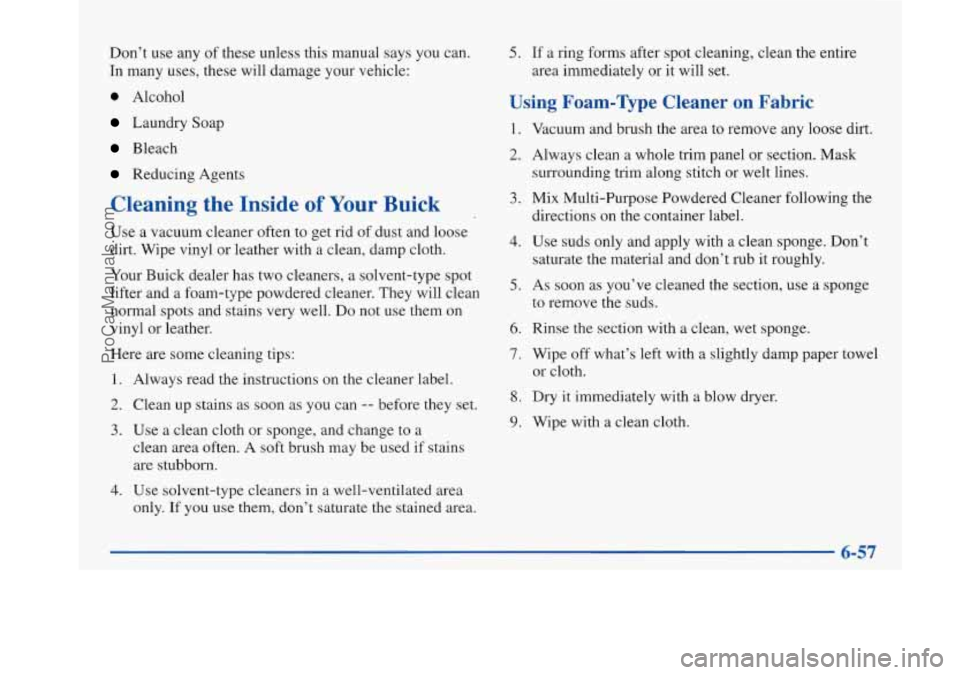
Don’t use any of these unless this manual says you can.
In many uses, these will damage your vehicle:
0 Alcohol
Laundry Soap
Bleach
Reducing Agents
Cleaning the Inside of Your Buick
Use a vacuum cleaner often to get rid of dust and loose
dirt. Wipe vinyl or leather with a clean, damp cloth.
Your Buick dealer has two cleaners, a solvent-type spot
lifter and a foam-type powdered cleaner. They will clean
normal spots and stains very well. Do not use them on
vinyl or leather.
Here are some cleaning tips:
1.
2.
3.
4.
Always read the instructions on the cleaner label.
Clean up stains as soon as you can
-- before they set.
Use a clean cloth or sponge, and change to a
clean area often. A soft brush may be used
if stains
are stubborn.
Use solvent-type cleaners in a well-ventilated area
only.
If you use them, don’t saturate the stained area.
5. If a ring forms after spot cleaning, clean the entire
area immediately or it will set.
Using Foam-Type Cleaner on Fabric
1. Vacuum and brush the area to remove any loose dirt.
2. Always clean a whole trim panel or section. Mask
3. Mix Multi-Purpose Powdered Cleaner following the
4. Use suds only and apply with a clean sponge. Don’t
surrounding trim along stitch
or welt lines.
directions on the container label. saturate the material and don’t rub it roughly.
5. As soon as you’ve cleaned the section, use a sponge
to remove the suds.
6. Rinse the section with a clean, wet sponge.
7. Wipe off what’s left with a slightly damp paper towel
or cloth.
8. Dry it immediately with a blow dryer.
9. Wipe with a clean cloth.
ProCarManuals.com
Page 322 of 420
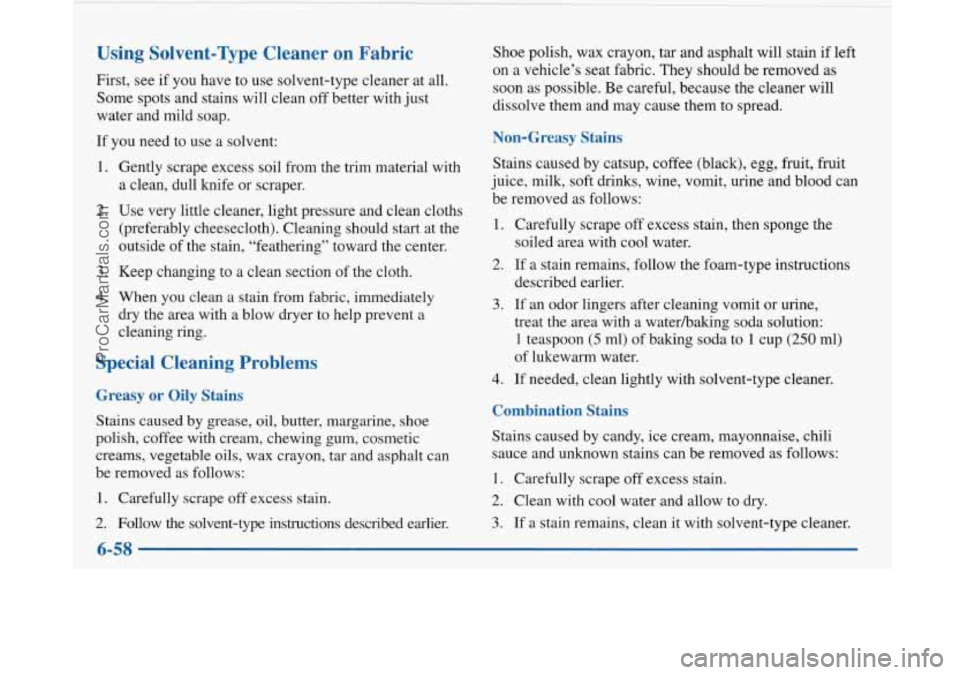
Using Solvent-Type Cleaner on Fabric
First, see if you have to use solvent-type cleaner at all.
Some spots and stains will clean off better with just
water and mild soap.
If you need to use a solvent:
1. Gently scrape excess soil from the trim material with
a clean, dull knife or scraper.
2. Use very little cleaner, light pressure and clean cloths
(preferably cheesecloth). Cleaning should start at the
outside of the stain, “feathering” toward the center.
3. Keep changing to a clean section of the cloth.
4. When you clean a stain from fabric, immediately
dry the area with a blow dryer to help prevent a
cleaning ring.
Special Cleaning Problems
Greasy or Oily Stains
Stains caused by grease, oil, butter, margarine, shoe
polish, coffee with cream, chewing gum, cosmetic
creams, vegetable oils, wax crayon, tar and asphalt can
be removed as follows:
1. Carefully scrape off excess stain.
2. Follow the solvent-type instructions described earlier. Shoe
polish, wax crayon, tar and asphalt will stain if left
on a vehicle’s seat fabric. They should be removed as
soon as possible.
Be careful, because the cleaner will
dissolve them and may cause them to spread.
Non-Greasy Stains
Stains caused by catsup, coffee (black), egg, fruit, fruit
juice, milk, soft drinks, wine, vomit, urine and blood can
be removed as follows:
1. Carefully scrape off excess stain, then sponge the
2. If a stain remains, follow the foam-type instructions
3. If an odor lingers after cleaning vomit or urine,
treat the area with a waterhaking soda solution:
1 teaspoon (5 ml) of baking soda to 1 cup (250 ml)
of lukewarm water.
soiled
area with cool water.
described earlier.
4. If needed, clean lightly with solvent-type cleaner.
Combination Stains
Stains caused by candy, ice cream, mayonnaise, chili
sauce and unknown stains can be removed as follows:
1. Carefully scrape off excess stain.
2. Clean with cool water and allow to dry.
3. If a stain remains, clean it with solvent-type cleaner.
6-58
ProCarManuals.com
Page 323 of 420

Cleaning Vinyl
Use warm water and a clean cloth.
Rub with a clean, damp cloth to remove dirt. You
may have to do it more than once.
Things like tar, asphalt and shoe polish will stain
if you don’t get them off quickly. Use a clean
cloth and a vinyl/leather cleaner.
See your dealer for
this product.
Cleaning Leather
Use a soft cloth with lukewarm water and a mild soap or
saddle soap and wipe dry with a soft cloth. Then,
let the
leather dry naturally.
Do not use heat to dry.
For stubborn stains, use a leather cleaner. See your
dealer for this product.
0 Never use oils, varnishes, solvent-based or abrasive
cleaners, furniture polish or shoe polish on leather.
immediately. If dirt is allowed to work into the
finish, it can harm the leather.
Soiled or stained leather should be cleaned
Cleaning the Top of the Instrument Panel
Use only mild soap and water to clean the top surfaces
of the instrument panel. Sprays containing silicones or
waxes may cause annoying reflections in the windshield
and even make it difficult to see through the windshield
under certain conditions.
Cleaning Speaker Covers
Vacuum around a speaker cover gently, so that the
speaker won’t be damaged. Some spots and stains will
clean off better with just water and mild soap.
If
something gets on one of them and you need to use a
solvent, follow these steps:
1. Gently scrape excess soil from the trim material with
a clean, dull knife or scraper.
2. Use very little cleaner, light pressure and clean cloths
(preferably cheesecloth). Cleaning should start at the
outside of the stain, “feathering” toward the center.
3. Keep changing to a clean section of the cloth.
4. When you clean a stain from fabric, immediately
dry the area with a blow dryer to help prevent a
cleaning ring.
6-59
ProCarManuals.com
Page 351 of 420

Short TripKity Maintenance Schedule
The services shown in this schedule up to 100,000 miles
(166
000 km) should be performed after 100,000 miles
(166
000 km) at the same intervals. The services shown
at 150,000 miles (240
000 km) should be performed at
the same interval after 150,000 miles (240
000 km).
See “Owner Checks and Services” and “Periodic
Maintenance Inspections” following.
Footnotes
The U.S. Environmental Protection Agency or the
California Air Resources Board has determined that the
failure to perform this maintenance item will not nullify
the emission warranty or
limit recall liability prior to the
completion of the vehicle’s useful life. We, however,
urge that all recommended maintenance services be
performed at the indicated intervals and the maintenance
be recorded.
# Lubricate the suspension, steering linkage, transaxle
shift linkage, parking brake cable guides and the
underbody contact points and linkage.
* If your vehicle has an Engine Oil Life Monitor, the
monitor will show you when to change the oil
-- usually
between
3,000 miles (5 000 km) and 7,500 miles
(12
500 km) since your last oil change. Under severe
conditions, the indicator may come on before
3,000 miles (5 000 km). Never drive your vehicle more
than
7,500 miles (12 500 km) or 12 months, (whichever
occurs first), without an oil change.
The system won’t detect dust in the oil.
So if you
drive in a dusty area be sure to change your oil every
3,000 miles (5 000 km) or sooner if the CHANGE OIL
light comes on. Remember to reset the Oil Life Monitor
when the oil has been changed. For more information,
see “Engine Oil Life Monitor” in the Index.
+ A good time to check your brakes is during tire
rotation. See “Brake System Inspection” under “Periodic
Maintenance Inspection” in Part C of this schedule.
ProCarManuals.com
Page 372 of 420
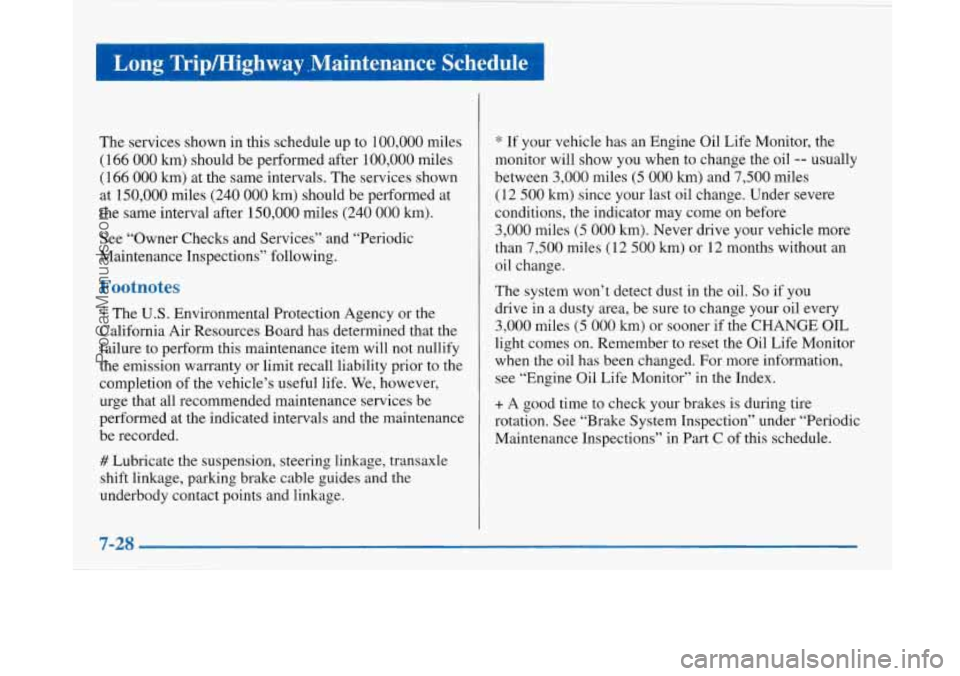
Long Tripmighway ,Maintenance Schedule I
The services shown in this schedule up to 100,000 miles
(166
000 km) should be performed after 100,000 miles
(166
000 km) at the same intervals. The services shown
at 150,000 miles
(240 000 km) should be performed at
the same interval after 150,000 miles
(240 000 km).
See “Owner Checks and Services” and “Periodic
Maintenance Inspections” following.
Footnotes
? The U.S. Environmental Protection Agency or the
California Air Resources Board has determined that the
failure to perform this maintenance item will not nullify
the emission warranty or limit recall liability prior to the
completion of the vehicle’s useful life. We, however,
urge that all recommended maintenance services be
performed at the indicated intervals and the maintenance
be recorded.
# Lubricate the suspension, steering linkage, transaxle
shift linkage, parking brake cable guides and the
underbody contact points and linkage.
* If your vehicle has an Engine Oil Life Monitor, the
monitor will show you when to change the oil
-- usually
between
3,000 miles (5 000 km) and 7,500 miles
(12 500 km) since your last oil change. Under severe
conditions, the indicator may come on before
3,000 miles (5 000 km). Never drive your vehicle more
than
7,500 miles (12 500 km) or 12 months without an
oil change.
The system won’t detect dust in the oil.
So if you
drive in a dusty area, be sure to change your oil every
3,000 miles (5 000 km) or sooner if the CHANGE OIL
light comes on. Remember to reset the Oil Life Monitor
when the oil has been changed. For more information,
see “Engine Oil Life Monitor” in the Index.
+ A good time to check your brakes is during tire
rotation. See “Brake System Inspection” under “Periodic
Maintenance Inspections” in Part
C of this schedule.
7-28
ProCarManuals.com
Page 384 of 420
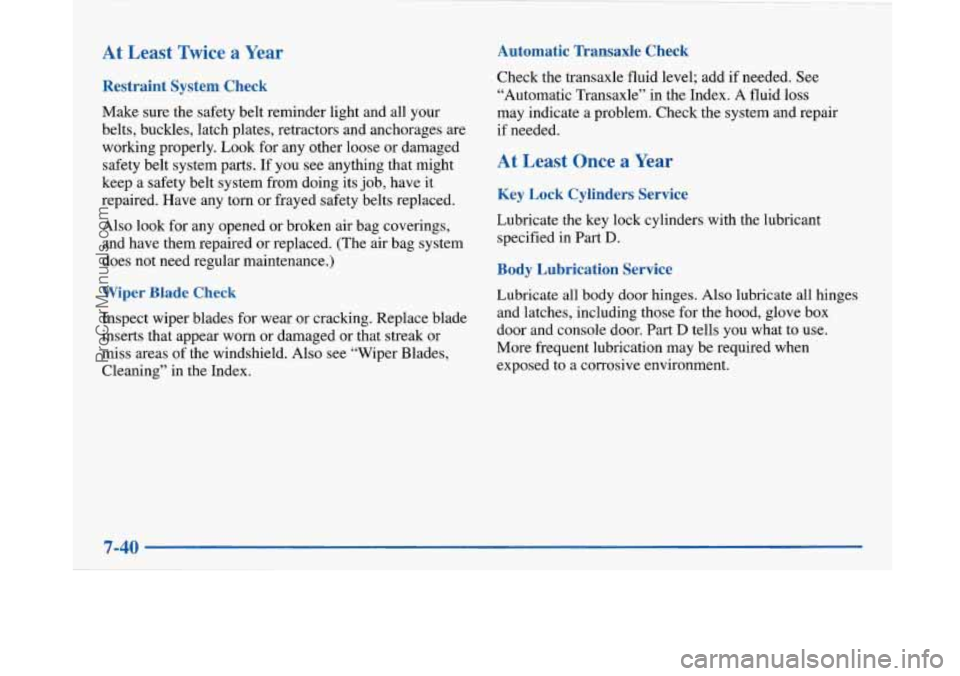
At Least Twice a Year
Restraint System Check
Make sure the safety belt reminder light and all your
belts, buckles, latch plates, retractors and anchorages are
working properly. Look for any other loose or damaged
safety belt system
parts. If you see anything that might
keep
a safety belt system from doing its job, have it
repaired. Have any torn or frayed safety belts replaced.
Also look for any opened or broken air bag coverings,
and have them repaired or replaced. (The air bag system
does not need regular maintenance.)
Wiper Blade Check
Inspect wiper blades for wear or cracking. Replace blade
inserts that appear worn or damaged or that streak or
miss areas of the windshield. Also see “Wiper Blades,
Cleaning” in the Index.
Automatic Transaxle Check
Check the transaxle fluid level; add if needed. See
“Automatic Transaxle” in the Index. A fluid loss
may indicate a problem. Check the system and repair
if needed.
At Least Once a Year
Key Lock Cylinders Service
Lubricate the key lock cylinders with the lubricant
specified in
Part D.
Body Lubrication Service
Lubricate all body door hinges. Also lubricate all hinges
and latches, including those for the hood, glove box
door and console door.
Part D tells you what to use.
More frequent lubrication may be required when
exposed to a corrosive environment.
7-40
ProCarManuals.com
Page 405 of 420
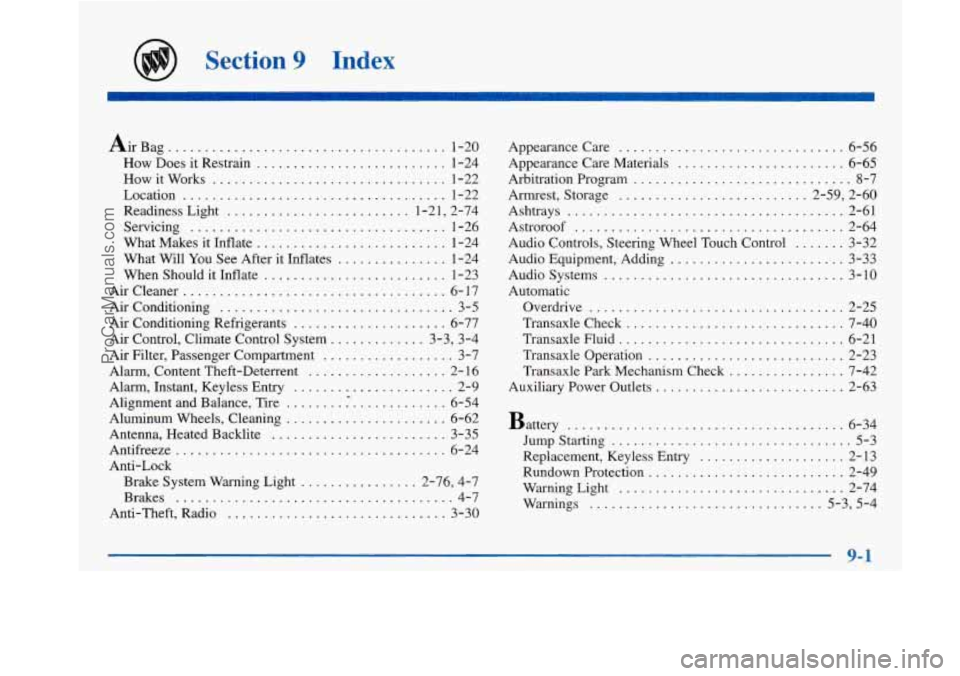
Section 9 Index
Air Bag ...................................... 1-20
How Does it Restrain
.......................... 1-24
How it Works
................................ 1-22
Location
.................................... 1-22
Readiness Light
......................... 1.21. 2.74
Servicing
................................... 1-26
What Makes it Inflate
.......................... 1-24
What Will
You See After it Inflates ............... 1-24
When Should it Inflate
......................... 1-23
Aircleaner
.................................... 6-17
Air Conditioning
................................ 3-5
Air Conditioning Refrigerants
..................... 6-77
Air Control. Climate Control System ............. 3.3. 3-4
Alarm. Content Theft-Deterrent
................... 2- 16
Alignment and Balance. Tire
....................... 6-54
Aluminum Wheels. Cleaning
...................... 6-62
Antenna. Heated Backlite
........................ 3-35
Antifreeze
..................................... 6-24
Anti-Lock
Brake System Warning Light
................ 2-76. 4-7
Brakes
...................................... 4-7
Anti.Theft. Radio
.............................. 3-30
Air Filter. Passenger Compartment .................. 3-7
Alarm. Instant. Keyless Entry
...................... 2-9 Appearancecare
............................... 6-56
Appearance Care Materials
....................... 6-65
Arbitration Program
.............................. 8-7
Armrest. Storage
.......................... 2.59. 2.60
Astroroof
..................................... 2-64
Audio Controls, Steering Wheel Touch Control
....... 3-32
Audio Equipment, Adding
........................ 3-33
Audio Systems
................................. 3-10
Automatic
Overdrive
................................... 2-25
Transaxle Check
.............................. 7-40
Transaxle Fluid
............................... 6-21
Ashtrays
...................................... 2-61
Transaxle Operation
........................... 2-23
Transaxle Park Mechanism Check
................ 7-42
Auxiliary Power Outlets
.......................... 2-63
Battery
................... ................ 6-34
Jump Starting
................................. 5-3
Replacement. Keyless Entry
.................... 2-13
Rundown Protection
........................... 2-49
WarningLight
............................... 2-74
Warnings
................................ 5.3. 5.4
9-1
ProCarManuals.com
Page 406 of 420
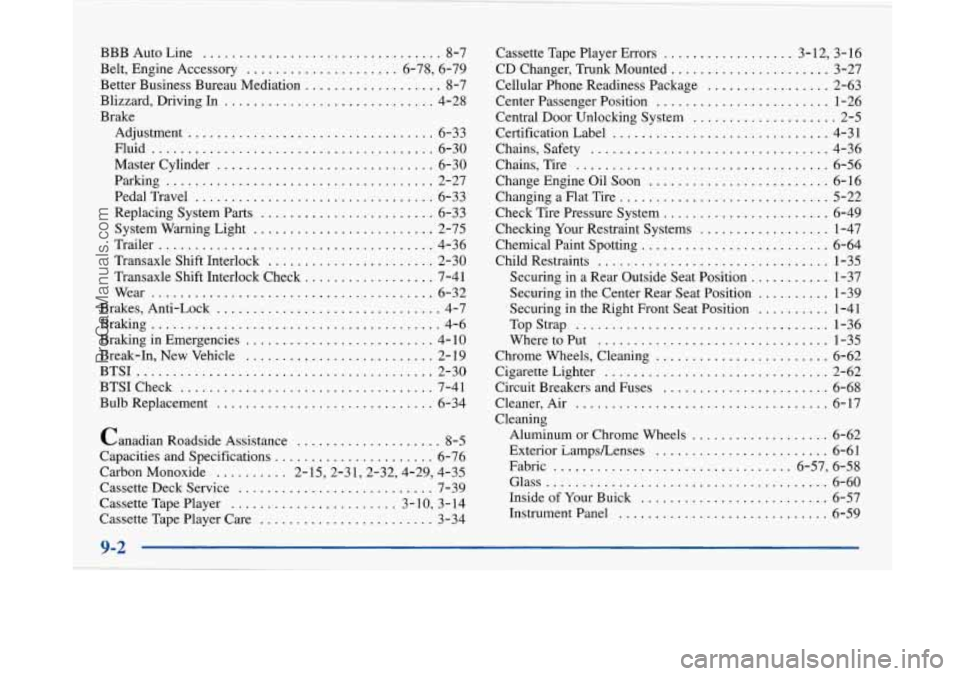
I I
BBB Auto Line ................................. 8-7
Better Business Bureau Mediation
................... 8-7
Brake Belt. Engine Accessory
..................... 6-78. 6-79
Blizzard. Driving In
............................. 4-28
Adjustment
.................................. 6-33
Fluid
....................................... 6-30
Master Cylinder
.............................. 6-30
Parking
..................................... 2-27
PedalTravel
.................................. 6-33
Replacing System Parts
........................ 6-33
System Warning Light
......................... 2-75
Trailer
...................................... 4-36
Transaxle Shift Interlock
....................... 2-30
Transaxle Shift Interlock Check
.................. 7-41
Wear
....................................... 6-32
Brakes. Anti-Lock
............................... 4-7
Braking
........................................ 4-6
Braking
in Emergencies .......................... 4- 10
Break-In. New Vehicle
.......................... 2- 19
BTSI
......................................... 2-30
BTSICheck
................................... 7-41
Bulb Replacement
.............................. 6-34
Canadian Roadside Assistance
.................... 8-5
Capacities and Specifications
...................... 6-76
Carbon Monoxide
.......... 2-15.2-31.2-32.4-29. 4-35
Cassette Deck Service
........................... 7-39
Cassette Tape Player
....................... 3- 10. 3- 14
Cassette Tape Player Care ........................ 3-34 Cassette
Tape Player Errors
.................. 3.12. 3.16
CDChanger. TrunkMounted
...................... 3-27
Cellular Phone Readiness Package
................. 2-63
Center Passenger Position
........................ 1-26
Central Door Unlocking System
.................... 2-5
Certification Label .............................. 4-31
Chains. Safety
................................. 4-36
Chains. Tire
................................... 6-56
Change Engine Oil Soon
......................... 6-16
Changing a Flat Tire
............................. 5-22
Check Tire Pressure System
....................... 6-49
Checking
Your Restraint Systems .................. 1-47
Chemical Paint Spotting
.......................... 6-64
Child Restraints
................................ 1-35
Securing in a Rear Outside Seat Position
........... 1-37
Securing in the Center Rear Seat Position
.......... 1-39
Securing in the Right Front Seat Position
.......... 1-41
TopStrap
................................... 1-36
Wheretoput
................................ 1-35
Chrome Wheels. Cleaning
........................ 6-62
Cigarette Lighter
............................... 2-62
Circuit Breakers and Fuses
....................... 6-68
Cleaner, Air
................................... 6-17
Cleaning Aluminum or Chrome Wheels
................... 6-62
Exterior LampsLenses
........................ 6-61
Fabric
................................. 6-57. 6-58
Glass
....................................... 6-60
Inside
of Your Buick .......................... 6-57
Instrument Panel
............................. 6-59
9-2
ProCarManuals.com